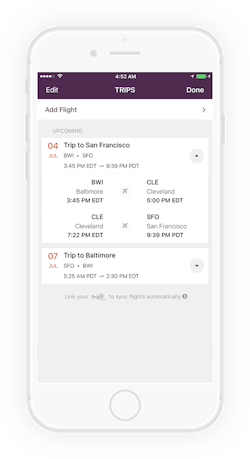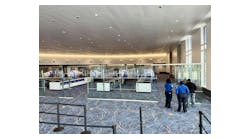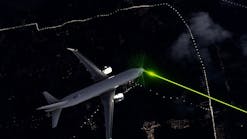As airports deal with a traveler base that’s spending more time in their terminals, the challenge has become to offer amenities that are unique and useful. One interesting trend is the creation of apps that allow passengers to order and pick up food and snacks from a variety of onsite restaurants.
To that end, three concepts -- Airport Sherpa, Grab and Host2Coast -- are hoping they can become dominant in the food/retail delivery app space.
Jim Schmitz is the vice president of innovation for Bethesda, Maryland-based food and beverage concessions operator HMSHost. The company released the second iteration of its app, Host2Coast, in eight airports in November 2016.
The app, available in the Apple and Google Play stores, allows travelers to locate nearby dining options, see their menus, and pre-order food at select locations in: Charlotte Douglas International Airport; Chicago O’Hare International Airport; Fort Lauderdale-Hollywood International Airport; George Bush Intercontinental Airport; Los Angeles International Airport; Miami International Airport; Phoenix Sky Harbor International Airport; and Seattle–Tacoma International Airport.
HMSHost is no stranger to airport food apps. In 2014, it launched the B4 You Board in select restaurants at Chicago O’Hare, Sacramento International, Phoenix Sky Harbor, Salt Lake City, and Minneapolis-St. Paul International airports. “B4 You Board was more of a test on functionality and to see if there was interest from passengers. As it went along, we tested that, but never expanded the program,” said Schmitz.
Host2Coast is a much better representation of what HMSHost wanted in an app, said Schmitz. “So we put it in our top nine locations, giving travelers locations and menus for every location in every airport. That didn’t happen with B4 You Board.”
The HMSHost app is more focused on its own locations, while Grab and Airport Sherpa work more with all concessionaires. “Ultimately our plan is to integrate the app with partners like airports, hotels and hotels with software that will allow this seamlessly,” he said. “We don’t think saturation is a bad thing. It gives travelers as many options as possible.”
The app allows travelers to find nearby restaurants, gives access to their menus and at some locations, pre-order a meal, pay and schedule a pick-up time for a food order up to four hours in advance. Travelers can also receive restaurant promotional alerts based on location.
Jeff Livney is the Chief Experience Officer for Houston-based Grab. The idea from the app came from Livney and his co-founders, who all traveled a lot. “Two of them came from the airline business via United Airlines and Continental Airlines, so they understood the passenger and the benefit of having apps that work across networks,” he recalled.
Concepts fail when there’s fragmentation and only single operators, said Livney. “We knew we had to have a product that was similar to the OpenTable [restaurant] app in order to be successful,” he said. “We also realized that we needed people from the airline industry who understood passengers, so we came together and founded the company in 2014.”
The founders spend time building Grab and launched it in Atlanta in October 2015. “Grab is now in close to 200 restaurants in 19 airports. It’s been exciting to develop and grow relationships with these restaurants,” he said. “We like that travelers see the value of Grab.
“We’re working on integrating our products onto existing apps on iOS or Android. We’re also in the process of embedding Grab inside the American Airlines app, which really boosts our distribution,” said Livney.
Grab will also add retail and duty-free shopping, said Livney. “We’ll be in our first location soon. When you think about it, it makes a lot of sense,” he said.
The size and reach of Grab is great, and it partners with HMSHost, said Livney. “Their locations will be available through the Grab platform. And if Airport Sherpa gets off the ground, we can eventually partner with them,” he said.
Patrick DellaValle, a co-founder of Airport Sherpa, says there are a few differences between his app and that of his competitors. “One key difference is that we offer travelers food pick-up and delivery, which we think is an important value proposition,” he said. “We offer a higher level of personalization that focuses on a travel centric approach.” His team is preparing to launch at Baltimore-Washington International Airport in the spring.
It all starts with a traveler’s flight information, said DellaValle. “With that, we can see departure times, connections and gates, which allows us to provide customized recommendations for food and retail,” he said. “It allows us to give a more personalized approach with the user experience.”
Both food and retail orders can be placed up to a week in advance and they will be delivered even if a gate changes. And if passengers want to pick up their own orders, the app includes walking directions with time estimates. Airport Sherpa is starting on the Apple platform, but will also develop an Android app, he added.
BWI was the launch airport for Airport Sherpa because of partner Alan Gluck’s relationship with officials and concessions operator Airmall, said DellaValle. “Our company is based in the D.C. area, so we spend a lot of time at BWI,” he said. “It has a good volume of diverse travelers and its layout is conducive to the concept.”
When it came time to pitch their concepts to airports, the companies took different approaches. HMSHost’ Schmitz said he didn’t need to pitch, since it was an extension of the brand. “When we launched the app in our first nine airports, we had other airports coming to us to be included in the rollout,” he said. “The challenge becomes when an airport wants it for other restaurants but they’re not HMSHost brands.”
Grab didn’t really have to pitch because it’s part of the airport restaurant and retail outlets’ distribution, said Livney. “We’re actually a way for them to maintain their businesses and retain customers who don’t have time to shop or wait for food,” he said.
Airport Sherpa views itself as a platform that provides value to different groups of people, said DellaValle. “We view Airmall, passengers, concessions and other potential partners like airlines as our customers, so we approach it from that standpoint,” he explained. “When we started our discussions with Airmall, we said that there was an opportunity to improve the passenger experience and bring in more incremental revenue to concessions, Airmall and the airport authority.”
When it comes to the technology needed to receive orders, Airport Sherpa works with individual operators using their platforms and integrating with that, said DellaValle. “It will be pretty individualized, since operators have different POS technology.”
For HMSHost, the key is seamless integration of a vendor’s POS and kitchen display systems, said Schmitz. “Unless we have this, the experience could be a disaster for passengers,” he said. “It’s all about the integration. Our operators must be able to provide the best experience. So if a manager has to key in an order, it could missed it when it’s busy. That leads to a bad customer experience and bad ratings.”
Like HMSHost, Grab focuses on integrating with its vendors’ POS systems, said Livney. “POS integration is very important because of the volume of orders that are coming in,” he said. “But we do have non-integrated solutions too where vendors and manage orders and we provide the technology needed to do it.”





